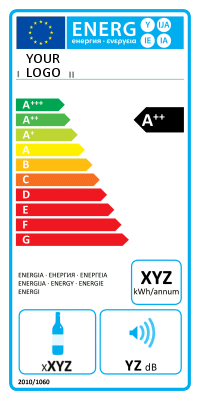|
|
Program To Create European Union Energy Efficiency Labels. All manufacturers of white goods (fridges, ovens etc.) now have to put standard energy labels on their appliances if they want to sell them in the European Union. Or rather the shop selling the appliance needs to place these labels close to, or on, the fridge, TV, dishwasher etc. Here are two examples (refrigerator and washing machine):
And here is a screenshot of the label making app: It was EU Directive 92/75/EC which established the previous energy consumption labelling scheme. But in 2010 a new labelling scheme was introduced, which also covers other things like space volume, water consumption, and noise pollution, etc. etc...
You can use the program on
this site to create the high resolution European Union energy label images
required. Why spend money on highly skilled graphics professionals, when
you can get it all done for a lot less and a lot quicker on this site?
Simply click on If you've ever looked at them
you'll know that the official definitions of the label sizes and colors
are complex and have blatant contraditions in them. With Once your label has been created we send you the 300 DPI image of it. If you have any special requirements just contact us. Labels for Refrigerators (Number 1060/2010). EU refrigerator labels show not only the class of refigerator, but also
Wine storage appliances are also covered in this regulation. That noise rating may seem a bit strange, aren't most fridges quiet enough anyway? Well yes, but absorption-type fridges are actually noiseless, but they consume significantly more energy than compression-type refrigerators. In order for shoppers to make an informed decision, information on airborne acoustical noise emissions (see the 38db icon above) of household refrigerating appliances should be included on the label. And though most fridges are pretty quiet, the electricity used by them accounts for a largish share of total household electricity demand in the Union. There is substantial scope for improving their efficiency even though there have been recent energy efficiency improvements. And to incentivise this change to more efficient fridges visible clear labelling is a must. Of two fridges, labels shown below, all esle being equal, which would you buy?
Hopefully your
company makes or stocks high class fridges, and you need to let your customers
know their ratings with these labels, which you can create quickly and
simply by clicking on this icon: Wine Storage Appliance Labels (part of regulation 1060/2010). Since wine storage refrigerators have different requirements to domestic regfrigerators here the EU energy label for them is slightly different:  As you can see there is no freezer compartment icon, but there is a "number of bottles" icon. Officially this is called the "Rated capacity in number of standard 75 centilitre wine bottles". The specification says that a "‘wine storage appliance’ means a refrigerating appliance that has no compartment other than one or more wine storage compartments". In other words these appliances are exclusively designed for storing wine either for long term wine storage or for bring wines up/down to the ideal drinking temperature.
Labels for dishwashers (Number 1059/2010). Unlike fridges there is only one version of the energy consumption label for dishwashers:
Not only does it tell you the
energy consumption but
also the water consumption: Click
here for more information on dishwasher labels. Click here: Note that the labels don't have to be on the boxes of the appliances, they have to be on display in the shop (sometimes called offially the "point of sale") for the customer to see. Some companies supply the labels directly to the shops. Labels for Televisions (Number No 1062/2010). Four different labels come into use as time moves on... ...click here for more details. It has been argued that a wider range of appliances, should be covered by energy labelling, but the lengthy testing procedure makes it difficult to include swiftly changing technologies. Still, the inclusion of televisions is progress in this area. The EU has made plans to expand the list to cover more products in future, including household boilers and vacuum cleaners Click here: |
|||
|
|
||||